Visual Arts & Installations
Musaj te Dzav

Artist: Hedina Tahirović Sijerčić, Lynn Hutchinson Lee
Image: Chad Evans Wyatt

Artist: Lynn Hutchinson Lee
Image: Chad Evans Wyatt

Artist: Lynn Hutchinson Lee
Image: Lynn Hutchinson Lee
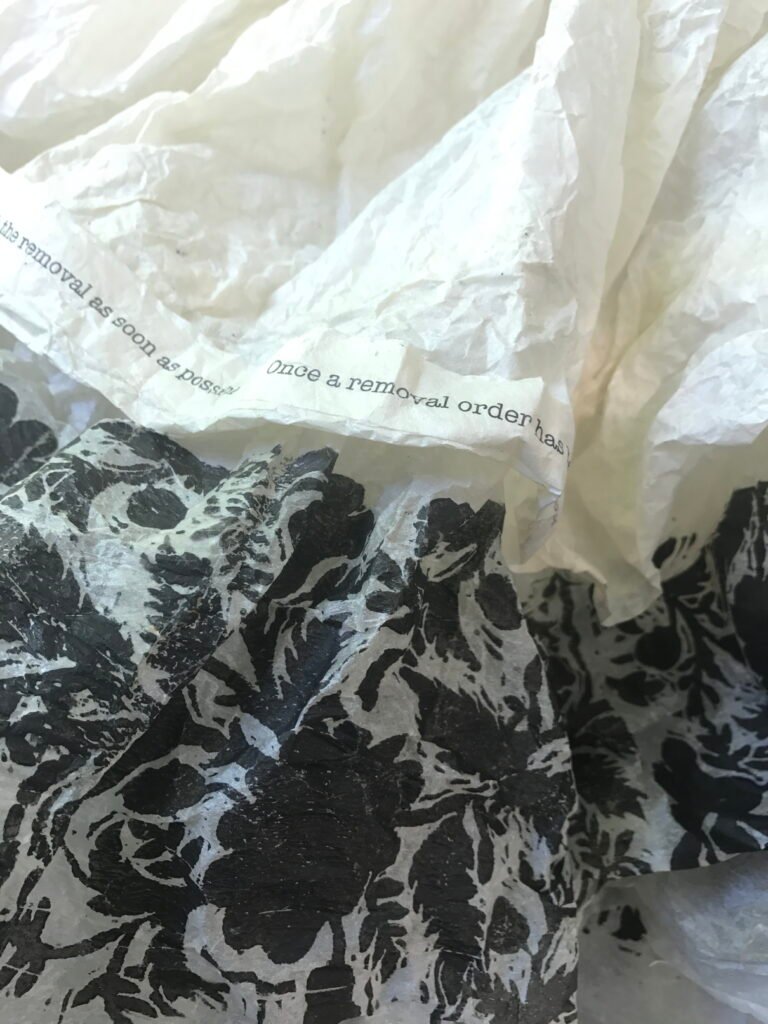
Artist: Lynn Hutchinson Lee
Image: Lynn Hutchinson Lee
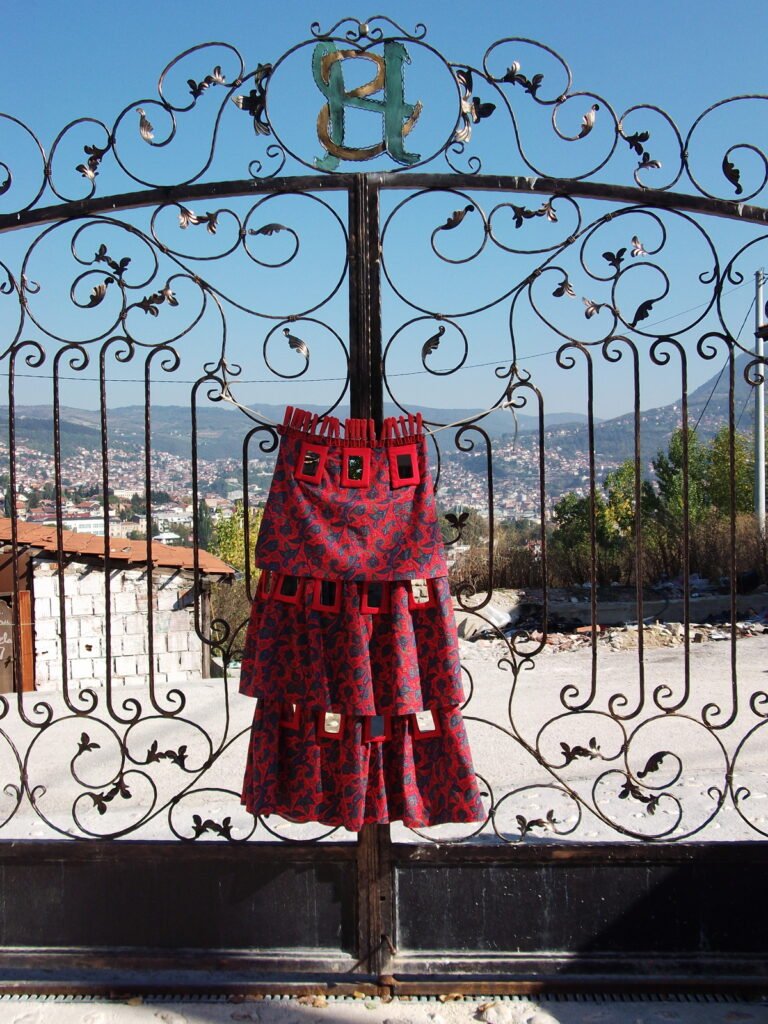
Artist: Hedina Tahirović Sijerčić, Lynn Hutchinson Lee
Image: Lynn Hutchinson Lee
Musaj te Dzav/ I Must Go (http://chiriklicollective.com/musaj-te-dzav-i-must-go/) is a project of chirikli collective. The project, comprised of a series of skirts, is based on the forced migration of Roma, following a historical trajectory that ends in present-day Canada. Through their work, the project artists speak to the resilience, strength and humanity of the Romani people. The ‘prologue’ is referenced in Europe, where many of the events whose images and texts we projected, printed, and affixed onto the skirts have taken place (from the Holocaust up to current human rights abuses and systemic racism and exclusion, including neo-Nazi violence).
The heart of the project is an installation of six skirts, a repository for present and historical narrative. Skirts traditionally represent the power of Romani women, with the potential to pollute or defile in a community context; but we transpose this power, showing defilement by forces external to the community (such as racism, forced migration) rather than from within. Furthermore, we use the skirts to show women’s strength, awareness, and hope.
The multimedia skirts made by Hedina Tahirović Sijerčić and Lynn Hutchinson Lee are constructed of fabric, thread, and gampi paper with konnyaku paste to stiffen, mould or sculpt the paper. Gampi paper, with its strong fabric-like qualities, is pleated, folded, crumpled and sewn.
The red mirrored skirt “Kon Dikhes/Who Do You See?” was designed and made by Hedina and Lynn in Sarajevo, and resides there. All other skirts were made in Toronto. The Holocaust skirt was designed and made by Hedina and Lynn. “Hungary, in Practice” and “Removal Skirt” were made by Lynn. Guest artists were Monica Bodirsky , “Policy Skirt” (photocopy on paper), “My Home” (digitally printed dye on cotton); and Riel Brown, “Untitled,” a skirt constructed of barbed wire.
Musaj te Dzav – with artists Monica, Riel, Hedina and Lynn, and photographs by Nihad Nino Pusija (http://www.fotofabrika.de/), and Romani secondary school students – was exhibited in 2015 at Gallery 50, Toronto, with photographer Chad Evans Wyatt’s portraits of Canadian Roma. (http://www.romarising.com/?tx=ca#Galleries)
Metanoia
Social Madness And Redemption
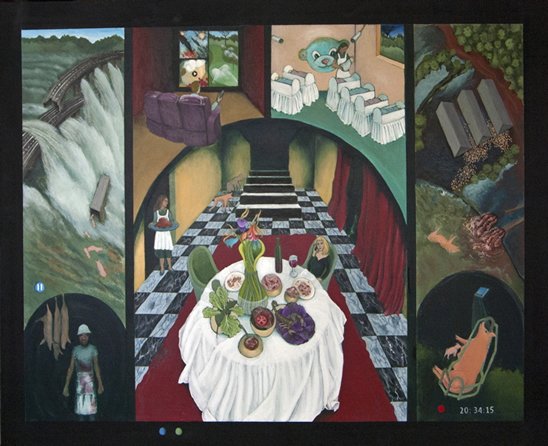

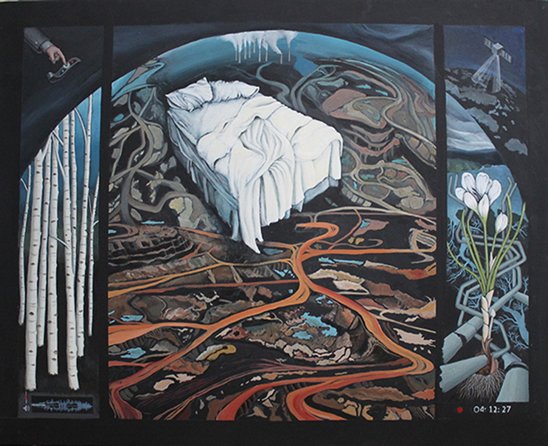

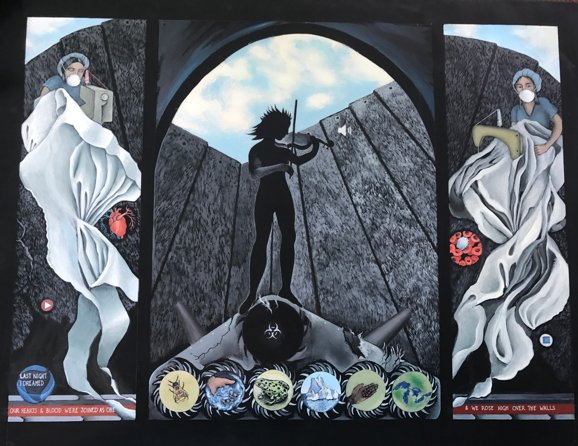
Metanoia charts the insinuation of social madness into our daily lives and bodies, and registers our gestures of resistance. The project, a series of drawings and paintings, takes its name from ‘the spontaneous attempt of the psyche to heal itself of unbearable conflict by melting down and then being reborn.’ Expanding the phenomenon of madness from the individual to the state, with its apparatus of globalized exploitation, surveillance, and devastation of lands and waters, metanoia is an exploration of outrages.
The inverted landscapes of metanoia, the monstrous foods, defiled lands, rivers of fabric sewn by children, walled compounds where women work under shreds of sky, are in our yards and our bedrooms, in the night shadows of our houses and streets. Digital clocks and recording devices silently mark the passage of this madness, and our response.
I exhibited an initial series of early metanoia images at the Toronto Free Gallery as part of the 2008 Mayworks Festival. That exhibition consisted of a series of exploratory drawings, the basis for six detailed paintings completed in 2014. These paintings, along with the initial drawings and the earlier series The End is also the Beginning, formed the 2014 metanoia installation at Workers’ Arts and Heritage Centre, Hamilton.
Art historian Laura Tibi writes: “Lynn Hutchinson Lee’s paintings evocatively capture the shifting moral impulse of our era by mobilizing a historical visual idiom to represent a contemporary problem. In doing so, she reminds us that the crisis is not an empirically new phenomenon, but rather an explosive accumulation of centuries of violence, dependency, and exploitation.” Read Tibi’s essay “On Representing the Crisis: A Response to Metanoia” here:
The End is Also the Beginning
Conceptualised like a graphic novel, the series of twelve small paintings from The End is Also the Beginning tells the before-and-after story of a small community ravaged by a multinational enterprise and ultimately liberated by its own inhabitants and their ever-present ancestors. Five of the paintings are shown here.

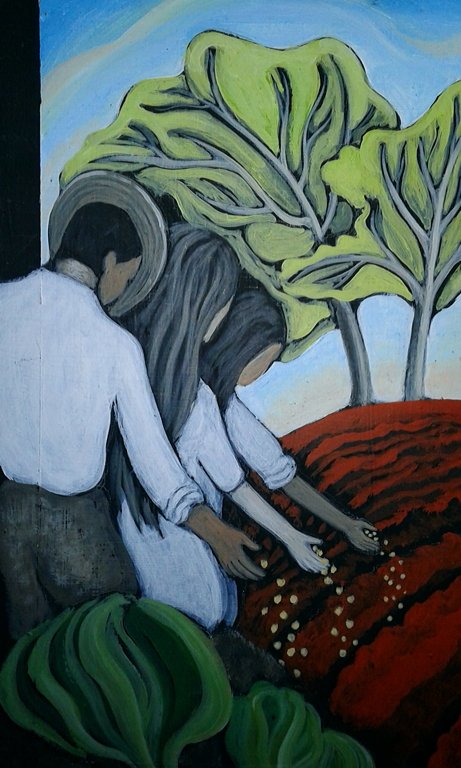
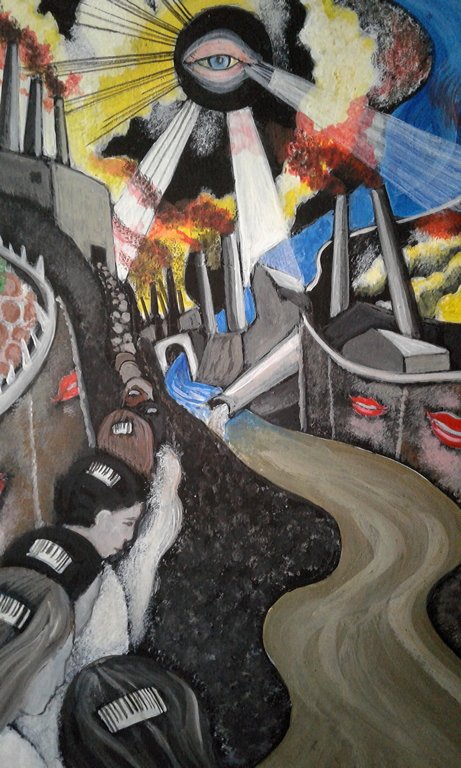
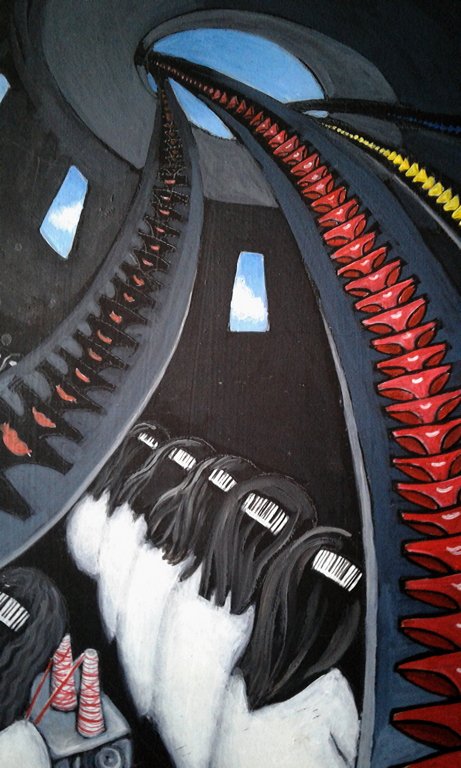

The End is Also the Beginning, part of the installation Inverted Landscapes/ Los Paisajes Invertidos, was one component of Art/Books on the Fence/ Libros al limite, Red Tree’s touring exhibition in Mexico. It travelled to Universidád Autónoma Metropolitana Xochimilco and Galería Epicentro, Mexico City, and to Veracruz State Museum of Art, Veracruz, and was later exhibited at Toronto Free Gallery and Workers Arts and Heritage Centre as part of metanoia.
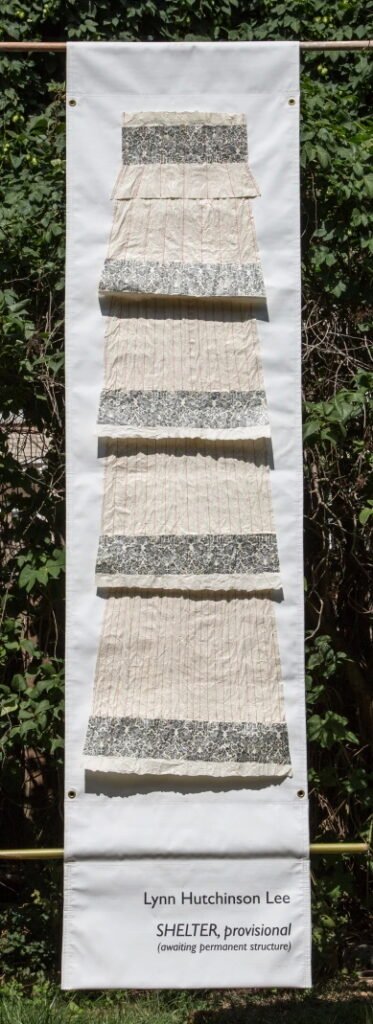
Shelter,
Provisional
Asylum seekers and refugees to Canada are held in a place of purgatory: an imposed and stultifying inertia, as their futures are being determined by boards, courts, adjudicators. My response to this, and to ‘aesthetic inertia’ is to address both the fluidity and permanence of women’s work in the context of this ‘waiting’, and to posit a sense of permanence – practically speaking, housing. https://enragedinertiaranoff.wordpress.com/lynn-hutchinson-lee/
Canada Without Shadows (CWS) was a project of Red Tree and chirikli collectives. Hedina Tahirović Sijerčić and Lynn Hutchinson Lee answered a call for submissions put out by Call the Witness, then curated by Suzana Milevska, for the 2011 Roma Pavilion, 54th Venice Biennale, Italy. Working between Toronto, Canada and Kerken, Germany, with meetings in Utrecht, Netherlands and Skopje, Macedonia, the artists began their first notes toward the larger project. It became a four-part sound installation, Canada Without Shadows.
This sound art installation—a project that developed as a collaboration between the two members of chirikli collective, Lynn Hutchinson Lee and Hedina Tahirović Sijerčić—is the result of a complex research undertaking in which the artists archived and juxtaposed various found and created sounds in the form of urban and natural soundscapes consisting of overlaying poetry verses, written and spoken by the artists, and spoken testimonies of five displaced Hungarian Roma women who fled Europe to seek refuge in Canada. The “whispering” voices convey the poetic transpositions of the promised imaginary land, Canada, starting from different subjective experiences of memories, cultural and ethnic displacement, precariousness, family joys and laments, and testimonies of shame. The sounds of the turning wheels of Lee’s family vardo (caravan) are intertwined with Sijerčić’s “dreams” of Romani children’s laughter, footsteps corresponding to elements in her poetry, and the sound of bombs in the Bosnian Roma ghetto. (Suzana Milevska)
From Call the Witness Press Release
The exhibition Call the Witness includes works by seven extraordinary artists who actively work from within and beyond their Roma identities. The works take up the role of “testimonies,” which in their own languages bear witness to past sufferings (such as the Holocaust) and of present and future anxieties, which seem to so intimately relate to the very existence of the Roma in our world. Each of these artists actively speculates about another possibility, and from within the Roma subjectivity proposes that we imagine how things could be otherwise.
This exhibition is part of a research trajectory leading to the realization of the Roma Pavilion in the context of the Collateral Events at the 54th International Art Exhibition – La Biennale di Venezia, 2011, organized by BAK. Commissioned by the Open Society Foundations and hosted by the UNESCO Venice Office located in the Palazzo Zorzi, the Roma Pavilion will emerge into a makeshift exhibition over time through the flux of additional testimonies—works of art, performances, talks, and conversations by and with artists, philosophers, and politicians, in which the situation of the Roma and Roma art are considered as emblematic for the world today, in order to speculate, in solidarity, about more hopeful futures.
Remarks on the Roma Pavilion
In the context of the Venice Biennale, the Roma Pavilion is a disruptive proposal. It tackles the paradox of a minority ethnic group lacking a nation, which lives within that sort of Leviathan that is the European Union. More than bringing visibility to Roma identity and culture, the main achievement of this initiative is to contribute to Roma’s cultural agency within globalized western institutions.
– Gerardo Mosquera, curator, Havana, Cuba
Further remarks on the Roma Pavilion here:
Call the Witness Press Coverage
And what to think of the Roma Pavilion, which found its home just outside of the Biennale terrain? It is organized by BAK, an Utrecht-based art institution and offers a platform to artists with no homeland. It is perhaps the most powerful signal to the others that the national pavilions in the Giardini are the story of the past. An idea of the Biennale as a sort of a world exhibition or a Eurovision-style competition, for which the countries delegate their ‘best’ artists, is herewith critically shaken.
– Sandra Smallenburg, “Politiek is overal op Biennale Venetie,” NRC Handelsblad, 4.6.2011 (in Dutch)
Roma Pavilion named one of the highlights of the 54th Venice Biennale: “Utrecht art institution BAK makes a Pavilion available to people with no permanent state: the Roma. In the opening week of the Biennale, a number of scholars and authors, amongst whom is Salman Rushdie, delivered lectures on subjects related to Roma culture.
– Sandra Smallenburg, “Hoogtepunten van de Biennale van Venetie 2011,” NRC Handelsblad, 9.6.2011 (in Dutch)
Further press coverage here: https://callthewitness.org/
Canada Without Shadows was installed at BAK (basis voor aktuelle kunst), Utrecht, Netherlands; Call the Witness, Second Roma Pavilion, Venice Biennale, Venice, Italy; and was curated into the exhibition “Good Girls–Memory, Desire, Power” at the National Museum of Contemporary Art, Bucharest, Romania.